|
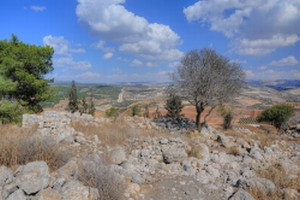 Adullam
Adullam
Note the archaeological remains of this Biblical city, located south of the valley of Elah.
This was the home village of Judah's wife,
daughter of Shuah, the hiding place of future king
David, and was fortified by King Rehoboam.
Location:
The following aerial view shows the points of interest, with
the hill of Tell Adullam in the center. The south side of the valley
of Elah is located on the
top-right side. The security fence, between Israel and the West Bank, is seen on
the bottom right side.
To arrive to the site you can either go south from Moshav-Aderet (the gate is
open during the day), or by a semi-paved road from Neve Michael / Rogalit.
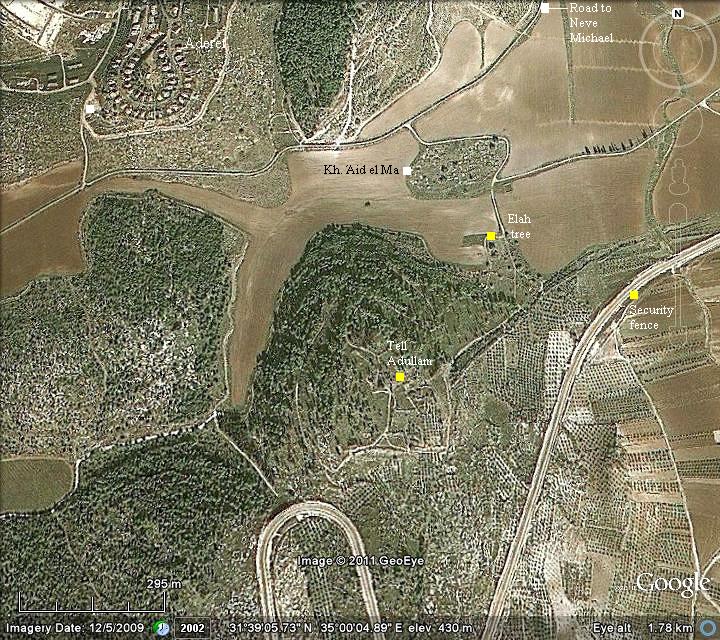
History:
Tell Adullam was first inhabited from the middle of the 2nd Millennium BC,
and was one of the Canaanite cities captured by Joshua during his campaign of
the cities of the Shephelah (Joshua 10 28-35).
Adullam appears in the Bible in several locations:
-
Judah's wife - Judah married his first wife, the daughter of Shuah
from Adullam, after he and his brothers sold Joseph to the Midianites
merchantmen (Genesis 38 1): "And it came to pass at that time, that Judah
went down from his brethren, and turned in to a certain Adullamite,
whose name was Hirah".
Judah's wife gave birth to two sons, Er
and Onan, who later died. His wife also died (Genesis 38, 12): "And in
process of time the daughter of Shuah Judah's wife died; and Judah was
comforted, and went up unto his sheepshearers to Timnath, he and his friend
Hirah the Adullamite". Judah then married his son's widow Tamar in Adullam (Genesis 38 20).
-
Conquest of Joshua -
Adullam is listed as one of the cities conquered by the Israelites (Joshua
12 7, 15): "And these are the kings of the country which Joshua and the
children of Israel smote on this side Jordan on the west... The king of
Libnah, one; the king of Adullam, one." Adullam became one of the
cities of the tribe of Judah (Joshua 15 20, ):"This is the inheritance of
the tribe of the children of Judah according to their families... Jarmuth,
and Adullam, Socoh, and Azekah, ". Its location according to this verse is
near Socoh (actually, the distance is 4KM to the north-west of Adullam).
After the battle of David and Goliath and David's victories over the
Philistines, he becomes the great hero of Israel. However, this caused his
relationship with King Saul to deteriorate.
| |
The jealous Saul tried to kill David, as illustrated here. David fled
to the Judean desert, and eventually came to Adullam where he hid inside
the cave together with his 400 followers.
1 Samuel 22:1: "David therefore departed thence, and escaped to the cave Adullam:
and when his brethren and all his father's house heard it, they went
down thither to him. And every one that was in distress, and every one
that was in debt, and every one that was discontented, gathered
themselves unto him; and he became a captain over them: and there were
with him about four hundred men.".
The cave of Adullam is also mentioned in David's speech after David
becomes King (2 Samuel 23:13): "And three of the thirty chief went down,
and came to David in the harvest time unto the cave of Adullam: and the
troop of the Philistines pitched in the valley of Rephaim". This is
repeated (in 1 Chronicles 11:15): "Now three of the thirty captains went
down to the rock to David, into the cave of Adullam;
and the host of the Philistines encamped in the valley of Rephaim". |
|
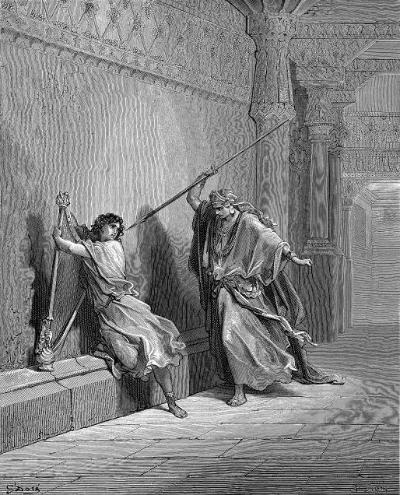
King Saul tries to kill David -
Drawing by Gustav Dore (French artist, 1832-1883) |
King Rehoboam, son of Solomon, fortified the city (2 Chronicles 11
5-12): "And Rehoboam dwelt in Jerusalem, and built cities for defense in
Judah. He built ... Shoco, and Adullam,
And Gath, and Mareshah, and Ziph, And Adoraim, and Lachish, and Azekah... And he
fortified the strong holds, and put captains in them, and store of victual, and
of oil and wine. And in every several city he put shields and spears, and made
them exceeding strong...".
The Assyrian empire, a rising force in the region, conquered the North Kingdom
of Israel in 732BC, destroying most of the cities and villages in the land.
|
|
The South Kingdom of Judah managed to survive
this onslaught by teaming up with the Assyrians, but not for long. After
the death of the Assyrian King Sargon II (722 – 705BC), King Hezekiah
mutinied against the Assyrians, joining other cities in the area who
attempted to free themselves from the Assyrian conquest.
Anticipating the coming Assyrian intrusion, he
fortified Jerusalem and the major cities, including Adullam. The
Assyrian army came in 701, leaded by Sennacherib, son of Sargon II (2
Chronicles 31 1): "After these things, and the establishment thereof,
Sennacherib king of Assyria came, and entered into Judah, and encamped
against the fenced cities, and thought to win them for himself".
According to an Assyrian clay tablet, Sennacherib conquered 46 cities
in Judea, including Adullam.
Adullam is also mentioned by the prophet Micah
the Morasthite, who describes this destruction of Sennacherib (Micah 1,
15): "Yet will I bring an heir unto thee, O inhabitant of Mareshah: he
shall come unto Adullam the
glory of Israel.". |
|
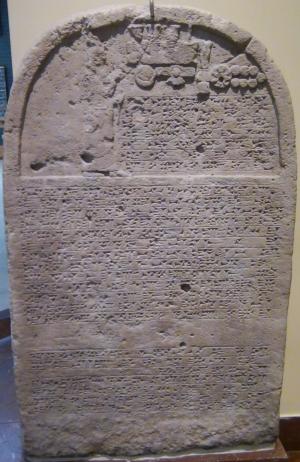
Sennacherib's stele with relief and
inscription; Nineveh; limestone [Istanbul Archaeological
Museum] |
After the return of the exiles to Zion, Adullam was one of the cities
resettled by the children of Judah (Nehemiah 11 25, 30): "And for the villages,
with their fields, some of the children of Judah dwelt... Zanoah, Adullam,
and in their villages, at Lachish, and the fields thereof, at Azekah, and in the
villages thereof.".
The site was abandoned during the Hellenistic or Roman period, as part of the
urbanization trend of migration from the high mounds to the new larger villages.
The area around the site was examined in the
Palestine Exploration Foundation (PEF) survey (1866-1877) by Wilson, Conder and
Kitchener. Tell Adullam appears on this map of 1878 in its Arabic form -
"Khirbet esh Sheikh Madhkur". In 1871 Conder visited the hill above these
ruins and provided a fascinating account (pp. 326-367) and explanation of the
identification of Adullam in the PEF 1875 quarterly summary.
Conder reported on Khurbet ed Sheikh Madhkur
(Adullam) in 1875 (p. 261):
|
|
"A steep and almost isolated hill,
with terraced sides, is surrounded on the north and west by a narrow
valley, which runs into the broad open corn valley on the east. The
place rises 300 to 400 feet above the valley, and is a position of great
natural strength, being only joined to the general range of hills on the
south by a narrow neck. On the summit stands the little Mukam, and round
it are heaps of stones and ruins extending over some distance. On the
north side of the hill near the top is a cave of moderate size. The rock
is quarried on the west, and on this side is a rock-cut tomb now blocked
up with a cross cut in front. In the branch valley on the north are two
wells, one apparently of great antiquity, with some 30 stone troughs
round it and full of water. To the east of this is a magnificent
Terabinth (Butmet wady es Sur). On the west, opposite the ruin, is a row
of caves on the sides of the narrow valley. These are used by the
peasantry in spring for stables. The cave on the hill itself was also
inhabited when visited". |
|
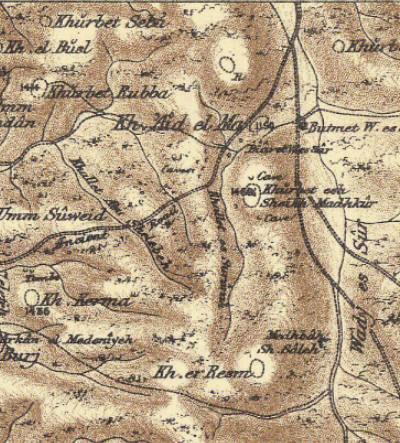
Part of Map Sheet 21 of Survey of Western Palestine, by
Conder and Kitchener, 1872-1877. (Published 1880, reprinted by LifeintheHolyLand.com) |
An Arab village is located in the valley north
of the hill, named Kh. Άid el Ma (see map above) - which may have
preserved the ancient name. Conder noted (p. 362): "I was struck by the
resemblance of the Hebrew word Adullam with that of a ruin called Ed el Miye,
situated on the road from Jerusalem to Beit Jibrin, not far from Shuweikeh or
Socho...". Conder's report on Kh. Aid el Ma (p. 347): "The name is at present
applied to some foundations and heaps of stones in the valley near the two great
wells. North of them there are ruined caves on the hillside, and two or three
cisterns. The name preserves that of Adullam, but the ancient site is described
under the head Khŭrbet esh Sheikh Madhkur." This report is part of the
fascinating accord of the exhibition's survey in Adullam.
Tell Adullam is part of the Adullam caves park. You can approach the site from
a north-east road, and climb up the steep hill. On the summit are few remains,
but you are rewarded by the great views of the hills of Bethlehem and the
sensations of being amidst the remains of this historic site.
Now where is the cave of David? There are many caves on the west side, but
none of them large enough to hold all David's men. Perhaps they hid in several
of the caves in the area. In any case, use your imagination and step into the
time machine.
[Our
thanks to http://biblewalks.com/Sites/Adullam.html for this
article.]
________________________________________________________
 The
Official
Tsiyon Road Android App 2.0 The
Official
Tsiyon Road Android App 2.0
Click image to
download app from Google Play
Easily
Listen to Tsiyon Road Messianic Radio from your Android device!
One listener says;
"Thanks for the new Tsiyon Road Android App. It makes it
SO easy for me to listen to all my favorite Tsiyon programs!"
________________________________________________________
 Tsiyon
Road on Glorystar Satellite! Tsiyon
Road on Glorystar Satellite!
Satellite coverage
for all of North America, Canada and much of South America. Glorystar has made an equipment package
available just for Tsiyon Road listeners. To find out more visit
our special Tsiyon Road page at:
http://tsiyon.glorystar.tv/
Need to talk to us? - In the USA and Canada just call us toll
free at (888) 230-2440 for help. Internationally, email us and we
will arrange a phone or Skype call for you.
From Eliyahu
This Shabbat we consider one of the most scandalous chapters in all
of the Bible, that is, Genesis 38. Over the millennia pious
religionists and Bible teachers of all stripes have had a habit of
avoiding this portion of Scripture whenever possible. Sometimes it
can't be avoided, at which times one is likely to hear all manner of
moralizing, speculating and all around pontificating, in an attempt
to get through the offending material, while also struggling to
retain some measure of religious decorum. In fact, it is often
suggested by embarrassed Bible teachers that this chapter shouldn't
really be in the Bible at all.
To all of those people I have only one thing to say; "Grow Up!"
We should be glad the Scriptures are not afraid to deal with
reality. Indeed, whatever religionists would like to hide in the
darkness, YHWH prefers to bring out into the light, where we can all
get a good look at it, the way He sees it. Genesis 38 has a message
of hope and encouragement for all of us, and especially for men. If
you want to hear the unvarnished and astonishing truth about Judah
and Tamar - and YHWH - don't miss this Midrash.
Blessings and
Shalom!
Eliyahu ben David
www.tsiyon.org
|
 "Tamar took off of her the garments of her widowhood, and covered herself with her veil, and wrapped herself, and sat in the gate of Enaim ..When Judah saw her, he thought that she was a prostitute, for she had covered her face."
"Tamar took off of her the garments of her widowhood, and covered herself with her veil, and wrapped herself, and sat in the gate of Enaim ..When Judah saw her, he thought that she was a prostitute, for she had covered her face."
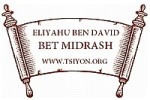







 Adullam
Adullam




 Tsiyon
Road on Glorystar Satellite!
Tsiyon
Road on Glorystar Satellite!